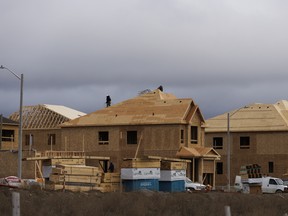
Article content
Ontario may be Canada’s most populous province, but it might soon cease to be the national leader in new housing construction. Recent quarterly data on housing starts, adjusted for seasonality and a six-month trend, reveals a startling reality: residential construction in Ontario is slowing, and other much less populated provinces are rapidly catching up.
THIS CONTENT IS RESERVED FOR SUBSCRIBERS ONLY
Subscribe now to read the latest news in your city and across Canada.
- Exclusive articles from Barbara Shecter, Joe O'Connor, Gabriel Friedman, and others.
- Daily content from Financial Times, the world's leading global business publication.
- Unlimited online access to read articles from Financial Post, National Post and 15 news sites across Canada with one account.
- National Post ePaper, an electronic replica of the print edition to view on any device, share and comment on.
- Daily puzzles, including the New York Times Crossword.
SUBSCRIBE TO UNLOCK MORE ARTICLES
Subscribe now to read the latest news in your city and across Canada.
- Exclusive articles from Barbara Shecter, Joe O'Connor, Gabriel Friedman and others.
- Daily content from Financial Times, the world's leading global business publication.
- Unlimited online access to read articles from Financial Post, National Post and 15 news sites across Canada with one account.
- National Post ePaper, an electronic replica of the print edition to view on any device, share and comment on.
- Daily puzzles, including the New York Times Crossword.
REGISTER / SIGN IN TO UNLOCK MORE ARTICLES
Create an account or sign in to continue with your reading experience.
- Access articles from across Canada with one account.
- Share your thoughts and join the conversation in the comments.
- Enjoy additional articles per month.
- Get email updates from your favourite authors.
THIS ARTICLE IS FREE TO READ REGISTER TO UNLOCK.
Create an account or sign in to continue with your reading experience.
- Access articles from across Canada with one account
- Share your thoughts and join the conversation in the comments
- Enjoy additional articles per month
- Get email updates from your favourite authors
Sign In or Create an Account
or
Article content
Article content
Construction began on 60,236 seasonally and trend-adjusted annualized dwellings in Ontario in June. Closely behind Ontario is Alberta, where work began on 58,882 dwellings at an annualized rate of construction. Meanwhile, Québec, Canada’s second most populous province, with 9.1 million people, is also trailing Alberta with 58,849 seasonally and trend-adjusted annualized starts.
Article content
Article content
By signing up you consent to receive the above newsletter from Postmedia Network Inc.
Article content
These figures should be a concern for policymakers in Ontario. Alberta, with fewer than five million residents, is now building almost as many homes as Ontario, which has a population more than three times the size of Alberta’s.
Article content
In a functioning housing market, new construction tends to align with population growth. Larger provinces, which attract more people and businesses, should, at least theoretically, lead in housing development. Yet, the evidence points elsewhere. Alberta and Quebec have accelerated residential construction, whereas Ontario and British Columbia appear to be stuck in a lower gear.
Article content
Interestingly, a large increase in new residential construction was recorded in June in British Columbia. However, when adjusted for the six-month trend, the sharp increase still leaves British Columbia’s starts behind the other three populous provinces.
Article content
Article content
This shortfall matters. A lack of adequate new housing supply has long-term implications for affordability. While rental markets across Canada have recently shown signs of softening, homeownership remains out of reach for many mid-income households, particularly in Ontario and British Columbia. The average selling price in places like Toronto has stubbornly stayed above the $1.1 million mark, far beyond the reach of average earners.
Article content
Article content
Decades of academic research and real-world experience have affirmed a central truth: when housing supply grows in tandem with demographic demand, prices and rents rise predictably and sustainably. However, when supply lags population growth, prices tend to increase rapidly, putting stress on household budgets and exacerbating inequality.
Article content
Residential construction in Ontario has been trending downward in the post-pandemic period. Understanding this decline requires a closer look at the composition of new housing. Much of Ontario’s recent construction, especially in cities like Toronto, has focused on multi-family dwellings, predominantly mid- and high-rise condominium and rental buildings. With weakening investor interest, tighter financing conditions and increased construction costs, the pipeline for such projects has become considerably thinner.

.jpg) 6 hours ago
1
6 hours ago
1
 English (US)
English (US)